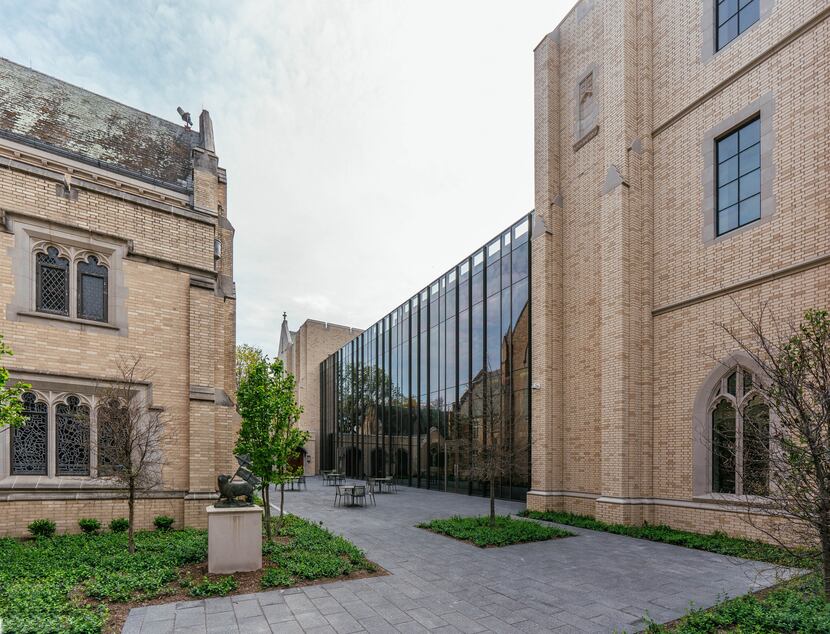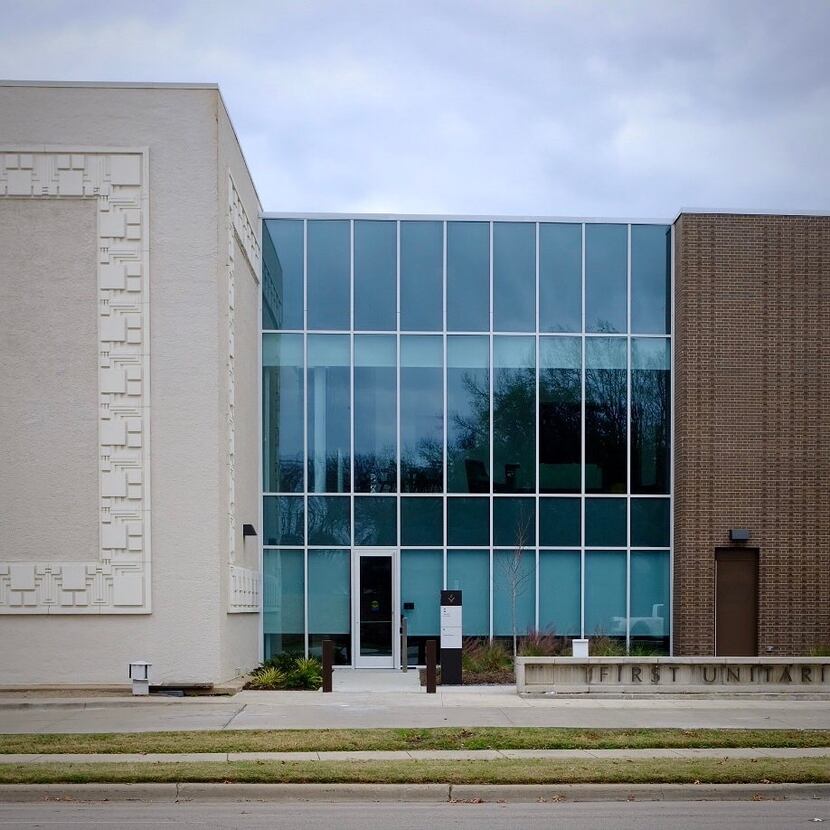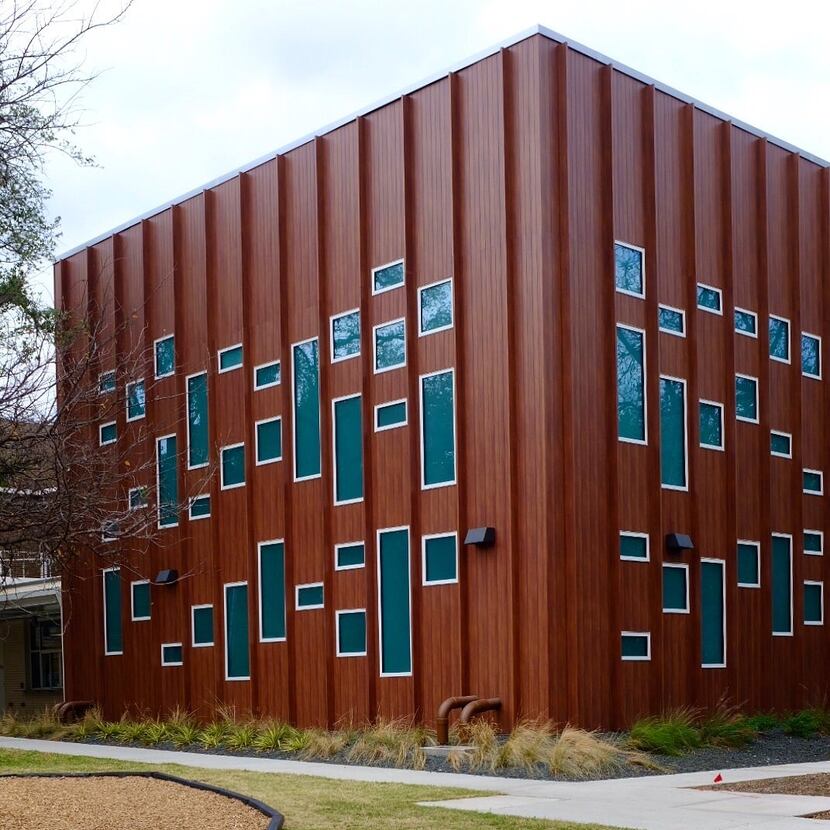A few months before Highland Park Presbyterian Church’s opening, in September 1941, this paper ran a story on the combination of old and new that characterized the architecture: “The ancient is, naturally, well tinctured with the very modern.” Dallas architect Mark Lemmon, who was also a church deacon, nimbly joined the spiked forms of the Gothic Revival with contemporary convenience (especially, air conditioning).
The same might be said of the recently completed expansion of the church, undertaken by Dallas-based architecture firm Omniplan, which inserts glass-box modernism into a Gothic Revival (or, more accurately, Re-Revival) shell.
The centerpiece of the project is the new three-story Hunt Building, which flanks Lemmon’s chapel on its west side, replacing an undistinguished 1980 addition by the now defunct local firm of Fisher & Spillman. The do-everything building establishes a new primary entry to the church campus, provides a community gathering space, a multipurpose events room, a double-height performance space, a library, administrative space, and two floors of underground parking.

Lemmon’s Gothic Revival was drawn from the work of Bertram Goodhue and Ralph Adams Cram, who practiced in a somewhat restrained version of that style in the early years of the 20th century. Omniplan’s Gothic Revival is drawn from Lemmon’s, but it is plainer and bulkier, without the dynamic vertical thrust that defines the Gothic and makes it so natural for spaces of elevated spirituality.
If it’s clunky, and it is, you can blame the essential conservatism of the client. The church’s trustees demanded a traditional design that would “respect” Lemmon’s sanctuary. The architects at Omniplan, to their credit, took considerable pains in that direction. The facades are composed of three tones of beige brick, effectively matching Lemmon’s original, and wherever their design bumps up against the historical sanctuary, it is separated by a glazed slot that reinforces the passage from new to old.
Among the signal virtues of Omniplan’s work was the making of direct connections across the campus, such that one no longer needs to navigate a warren of hallways and structures to get from the Hunt Building to the education complex, located on the far side of the sanctuary.
But the misplaced presumption here was in thinking that only a Gothic Revival design could honor Lemmon’s building and maintain the architectural integrity of the church campus. That isn’t so, and in an ironic twist, Omniplan’s design is most successful (and most respectful) when it drops the traditionalist pretense and embraces modernity.

Hidden from the street, facing a small internal garden on the east side of the Hunt Building, is a two-story glass curtain wall, articulated by vertical fins, that encloses a large foyer and majestically frames Lemmon’s sanctuary building. New respects old.
The point is made with equal drama by the Hunt Building’s most appealing space, a double-height performance hall or “music room” on its second floor. From the street, it peeks above its brick Gothic Revival base, a glass-enclosed jewel box, lined in steel.
At the First Unitarian Church of Dallas, Gensler architects have followed a different strategy in the face of a similar challenge: a landmark sanctuary lacking space for community gathering and a campus of buildings in need of unification.
In contrast to Lemmon’s Gothic Revival complexity, the architect Harwell Hamilton Harris gave Unitarian a windowless, white stucco cube, its only decoration being a patterned band of geometric blocks. His models were two of America’s most significant works of architecture: Louis Sullivan’s Wainwright Tomb in St. Louis (also a windowless block ornamented by a patterned band) and Frank Lloyd Wright’s Unity Temple in Chicago (a square Unitarian worship hall.)

The defensive nature of Harris’ 1964 building, which he described as “a clearing in the forest,” was not accidental. “At that time, they were about protecting this progressive community from conservative Dallas,” says Daniel Kanter, First Unitarian’s senior minister.
Dallas, and Highland Park within it, remains a conservative place, but such a withdrawn, inward looking face to the community no longer seemed appropriate for the congregation.
“One of the phrases that we coined during the process was making the campus ‘radically welcoming,’” says Paul Manno, the architect in charge of the project for Gensler’s Dallas office.
A first order of business was replacing Harris’ entry arcade, essentially a blank wall facing Preston Road, with a sheer, blue-glass curtain wall. “The reason you see so much glass is to bring in daylight, but also to make it transparent,” says Manno, noting that Harris’ design “shut out the neighborhood.”
Adjacent to this is a two-story circulation space, faced with bricks that alternate in their orientation, creating a textured surface that contrasts with the flat stucco of the chapel and the glazed façade.
The main entry has been shifted around the corner, to Normandy Avenue, and through the former Raible Chapel, a modest 1944 structure of horizontal bands of cut Tennessee stone. The interior, which was largely unused, has been repurposed as a sitting area named for Patricia Davidson, a leading advocate of women’s reproductive rights. From the entry, a visual axis runs through the entire campus, linking community, worship and education spaces.
As at Highland Park Presbyterian, Unitarian’s landmark sanctuary is treated deferentially, with a glazed skylight wrapping the edges of Harris’ cube, separating the new from the old.

The heart of the expansion project, and the new core of the complex, is Channing Hall, a square block offset and to the rear of Harris’ white box. While it mimics the historic sanctuary’s cubic form, in character it is markedly different. With an exterior of warm-toned cedar panels animated by asymmetrically oriented windows, it appears buoyant where its predecessor was stoic. Within, the 17,000-square-foot multipurpose space is bright and open, illuminated by a grid of rod-shaped lights suspended from the ceiling.
A glass-curtain wall, textured brick, wooden siding: maintaining a consistent aesthetic or material vocabulary was clearly not a priority in the reimagining of Unitarian’s campus. But an absence of uniformity can be a form of strength, and for a progressive congregation, diversity is an appropriate metaphor.
“I like this way of nodding back at the past,” says Manno, “of not finding a whole new language, but maybe a new verb.”

